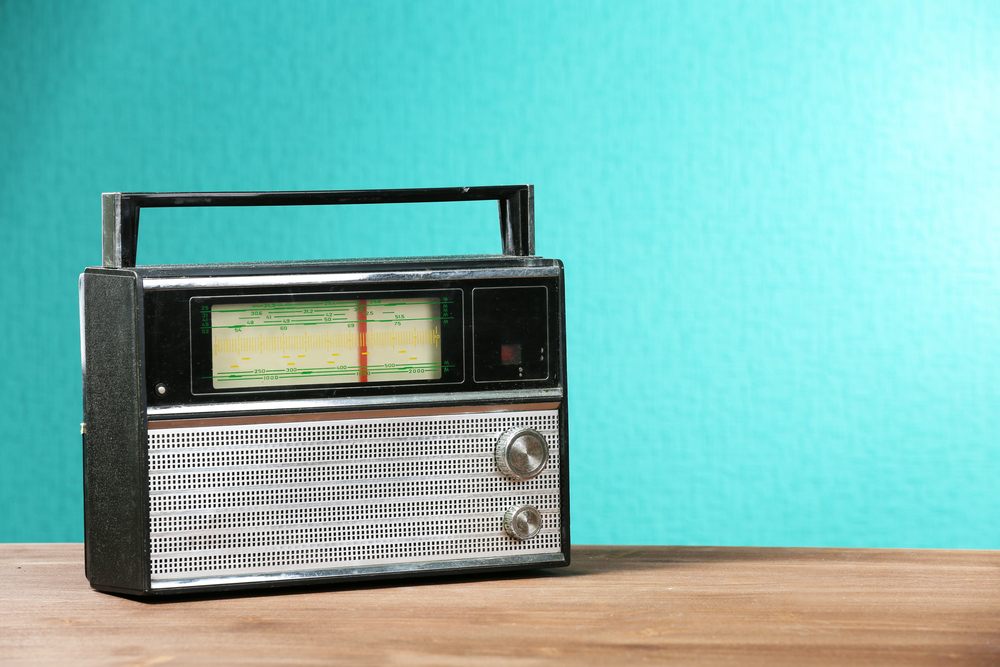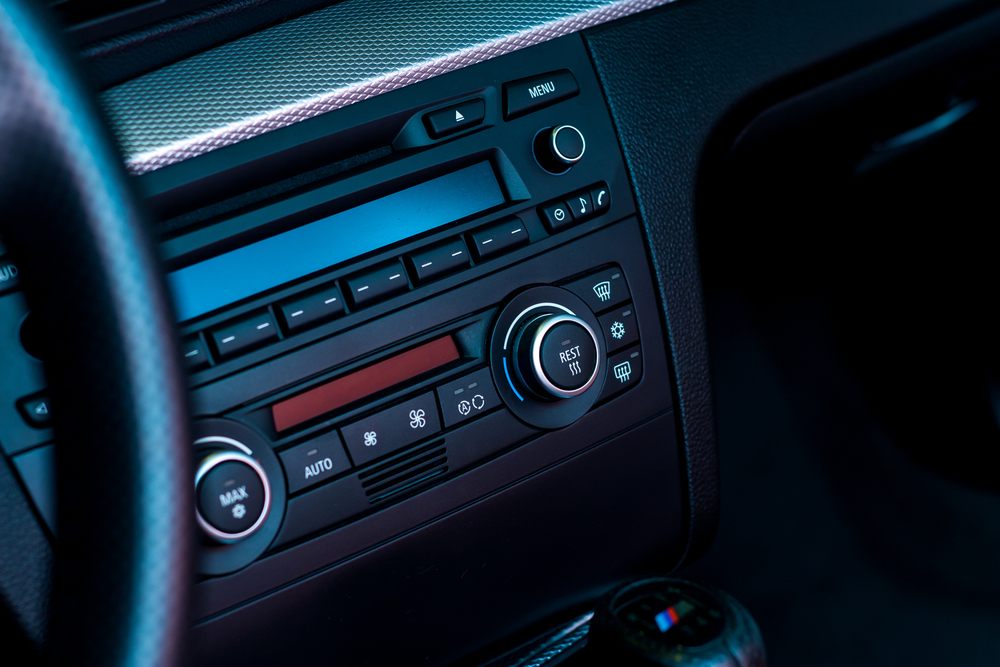The Sneaky Way Broadcasters Are Using TV on the Radio
Chicago, for one, has a semi-secret FM station.

The station 87.7FM is is actually analog TV station Channel 6. (Photo: Africa Studio/shutterstock.com)
A version of this post originally appeared on Tedium, a twice-weekly newsletter that hunts for the end of the long tail.
TV on the Radio isn’t just the name of a really good band.
It’s also a quirk in the design of analog television, a medium that has largely been usurped by its digital equivalent.
But a funny thing happened on the way to obscurity: As analog TV gave way to digital, a handful of risk-taking broadcasters, sensing an opportunity, have started to run those analog TV stations as FM radio stations—big FCC plans be damned. The shift is surprisingly contentious in the world of broadcast.
And it all comes down to the special superpowers of the VHF-driven channel 6.
If you find your FM radio dial sitting at 87.76 MHz, you’re probably picking up the audio feed of the analog VHF station channel 6. That placement is through sheer happenstance: Channel 6 takes up spectrum between 82.0 through 88.0 MHz.
And while the 87.7 tuning technically falls below the reach of some radios, it can be accessed by many cars, especially older models.
Due to the fact that VHF uses a similar audio standard to FM, it can be picked up on the radio, even if, in 2009, the digital television switchover was meant to kill off analog television.
This happened mostly to open up that analog spectrum for other uses, like mobile phones, whose makers have been licking their chops.
And broadcast stations, for the most part, have been on board, even if they’re setting an incredibly high price for that spectrum: The FCC is paying $86.4 billion for spectrum that it plans to auction off, which, as the Wall Street Journal helpfully notes, is a price tag higher than the market cap of T-Mobile and Sprint combined. (It should be noted that some local stations are being offered deals by the FCC to go off the broadcast airwaves completely, in favor of cable and satellite television-only offerings.)

87.7 can be accessed by cars, especially older models. (Photo: Bigdoug2005/shutterstock.com)
But there are a few holdouts on the analog front, and many of them are flittering around on channel 6. Here’s why: Despite the fact that full-powered analog stations were forced to shut off in 2009, low-powered television (LPTV) stations were allowed to stay on the air in analog form. Some stations with access to the channel 6 VHF signal took advantage of this exception to start broadcasting on the radio—moving beyond simply a nice side effect and into a way to slightly expand the FM dial a little bit.
Technically, these stations, called FrankenFMs in the industry for their cobbled-together nature, have to broadcast with a video signal of some kind, but it’s basically just a way to get around federal regulations. This phenomenon has proven helpful for certain types of audiences underserved by traditional radio, and has led to a number of small stations, like Cleveland’s Latino-focused “La Mega,” call sign WLFM-LP, finding a new home on the dial.
But the situation became so troublesome that in 2014, the FCC, when delaying the low-power television shutoff, actually suggested making the pseudo-FM stations into a permanent thing, and called for comments around that time.
La Mega, for one argued that it was playing a valuable role in its community—and that similar stations do the same.
“Licensees already providing the service are adding to the overall competitive environment in their communities, and are making optimal use of the spectrum to the overall betterment of Section 307(b) of the Communications Act,” the station wrote in its letter.
But weirdly, much of the station’s letter was focused on criticizing NPR, which has critized FrankenFM stations in the past, mostly because the frequencies to the left of the dial were supposed to have been set aside for stations, like NPR, in the public interest or college radio stations.

Analog TV stations were forced to shut off in 2009. (Photo: David Beach/CC BY 2.0)
Stations like La Mega, NPR has argued, subvert the FCC’s original purpose in switching to digital television.
“The promise of digital television long touted by the Commission should amount to more than an LPTV station masquerading as an analog FM radio station,” NPR has said, even devoting some pretty extensive research into the issue, showing that FrankenFMs have a tendency to negatively affect the quality of FM radio signals.
The TV on the radio phenomenon—it’s been around for decades—wasn’t always so hotly disputed, or even interesting.
Things changed, though, in 2008, with analog television preparing for its sunset, when the format suddenly got a bit more fascinating. That’s largely thanks to the TV broadcaster Venture Technologies, which started experimenting with the radio dial location in Chicago in 2009 just as the final analog TV broadcasts went off the air.
Venture, using the call signs WLFM, first tried its hand at alternative country, possibly hoping to win over some of the city’s Wilco fans. But thanks to some quick thinking, the company soon found an opening, after a smooth jazz station went off the air. Within hours, Venture switched its station’s own format to smooth jazz, quickly winning over listeners who prefer things to be smooth, rather than frustrating.
But ultimately, smooth jazz didn’t stick, and Venture quit running the station itself, blaming the unusual situation around its FM signal as the primary reason it gave up the format.
Since then, the station has been licensed out to different companies, who have each played with a wide variety of experimental formats, including alternative rock, sports talk radio, and even rebroadcasting WGN’s AM signal on the FM dial.
But it’s the station’s latest format that’s arguably its most interesting. Taking some clear inspiration from the recent trend of digital subchannels that play incredibly old TV shows, Weigel Broadcasting, which owns MeTV, launched a licensing agreement to run the station last year and has since been running it as MeTV-FM, an oldies station that isn’t afraid to play some stuff that hasn’t seen the light of day in a few decades.
The station, call sign WRME, plays stuff like James Taylor, Air Supply, and Paul Simon without flinching, sometimes diving into songs that don’t get a ton of regular play on normal oldies stations. The strategy is working; it’s kicking ass in the ratings despite the fact that some cars can’t even play it. In March, the station netted the highest-ever rating received by a FrankenFM.
MeTV-FM has gotten some great reviews from radio fans, one of whom, internet radio programmer Bruce David Janu, recorded a video of himself listening to the station on his drive into work.
“Perhaps MeTV-FM is the first station in town to recognize that the competition is not other terrestrial radio stations, but internet radio—mainly Pandora and Spotify,” Janu wrote on his Vinyl Voyager Radio website. “And they created their station to emulate the variety that internet stations offer. And it is working.”
At Radio Survivor, which has been closely watching the FrankenFM phenomenon, the website’s Paul Riismandel argued last year that the success that the station is seeing could lead Weigel to make a bigger play on a part of the radio dial that isn’t showing up due to a technological fluke.
“Beyond it being a back-door FM station, MeTV FM is an interesting experiment, because by all accounts it’s a fresh take on an old format,” he wrote. “It will be all the more fascinating if it can make the jump to a legitimate FM station.”
For now, these FrankenFM stations will stay on the air, having earned a reprieve last April. But who knows how long that’ll last?
There’s a lot of money at stake, for one thing. And the whole conflict highlights another lingering tension: that between broadcasters and mobile providers. Last year, for example, the National Association of Broadcasters raised an issue with phone makers who have basically refused to turn on the FM radio chips built into phones, despite the fact that they’re baked in.
Those same phone makers, through the wireless signals that their devices rely on, are causing severe changes in the television market. But the mere existence of MeTV FM highlights a big problem with radio as a whole: There isn’t enough spectrum to go around, and what exists is stretched too thin.
We are reaching the limits of radio, in other words, a technology that is still useful, that everyone has, but that needs a bit more variety to stay in the game, even if, sometimes, an extra station or two might be nice.
When I was a kid, I remember there being something magic about the quirk that TV on the radio gave us. It was the trick that, when separated from Saturday morning cartoons, allowed Muppet Babies to keep playing. Well, at least in audio form.
That it was essentially a quirk of the airwaves, I didn’t know that at the time, but it makes a lot of sense. To see it come back in this specific way is kind of awesome—it shows that given the right tools, someone out there is going to bend it to their will.
A version of this post originally appeared on Tedium, a twice-weekly newsletter that hunts for the end of the long tail.










Follow us on Twitter to get the latest on the world's hidden wonders.
Like us on Facebook to get the latest on the world's hidden wonders.
Follow us on Twitter Like us on Facebook